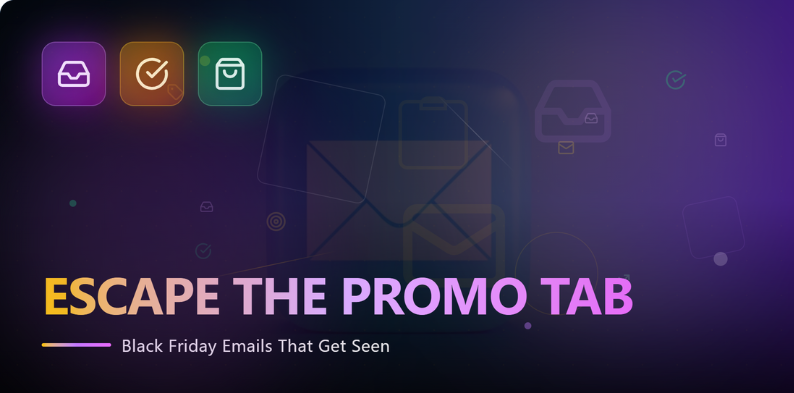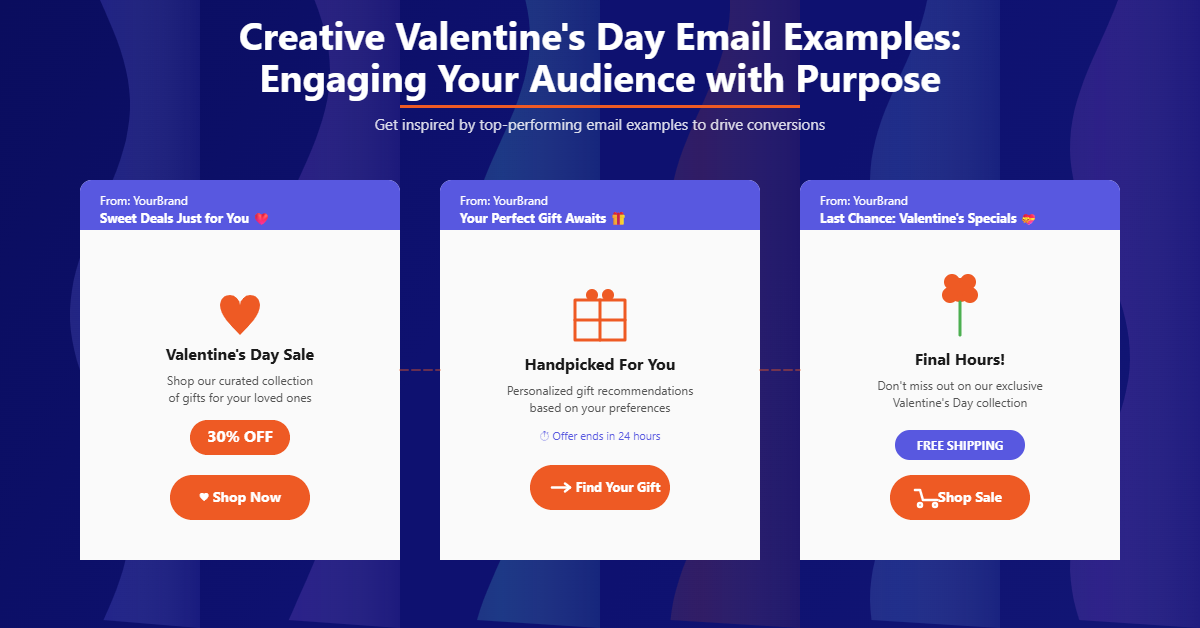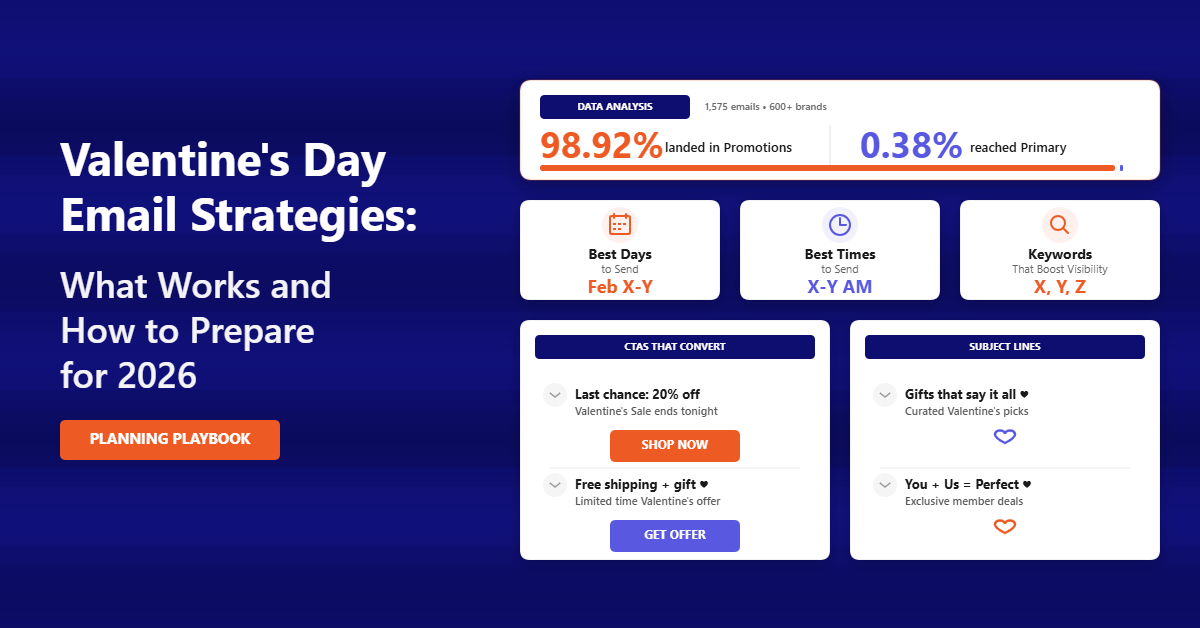Quick Summary
💡 Simplicity Wins: 77% of Black Friday campaigns focused on broad, clear sales, with numeric discounts like “Up to 50% off” outperforming vague savings language.
✉️ Subject Line Strategy: Keywords such as “early,” “sale,” and “exclusive” appeared consistently in successful inboxed emails, with “early” mentioned 26 times and “sale” 1,064 times.
🔍 Preview Text is Crucial: 98.01% of high-performing emails used preview text to complement, not repeat, the subject line, enhancing clarity and urgency.
🎯 Strategic Offer Framing: 55.92% of emails used numeric discount framing, with specific offers like “Up to 50% off” leading to higher engagement than vague savings language.
🛒 CTA Clarity: Over 60% of CTAs were purchase-driven, with “Shop now” (381 uses) and “Shop sale” (54 uses) proving more effective than creative or ambiguous CTAs.
Over the 2024 & the ongoing 2025 Black Friday campaigns, we analyzed 5,025 emails from 1,404 brands to separate hunches from patterns.
The results reveal clear signals in subject line keywords, CTAs, offer framing, and creative choices that correlate with better placement and higher-intent clicks.
If you’re planning your Black Friday Email Ideas, this is your first step in the playbook.
What 5,000+ Emails Reveal About Black Friday Email Performance
This dataset captures behavior across 1,404 brands. Black Friday messaging is heavily concentrated around clear offers, straightforward calls to action, and time-bound framing.
Brands rely on simplicity more than creativity to earn clicks, and a small percentage of creative or emotional copy still makes it to the inbox when executed with discipline.
General Black Friday Sales dominate the landscape at roughly 77% of campaigns.
Sitewide and storewide promos account for about 13%, doorbusters and mega discounts around 12%, and limited-time urgency tactics near 10%.
Category-specific pushes show up in only about 5% of sends. That split reflects a simple truth: broad discounts and frictionless CTAs do the heavy lifting, while specificity and novelty help you stand out when layered strategically.
Subject Lines That Reach the Inbox
The words that work
Among emails that reached the inbox, a tight set of words repeatedly shows up: early, sale, deals, access, starts, last, savings, sitewide, and exclusive.
While each individual count is modest in the inbox cohort, the consistency is telling. Early appeared 26 times, sale 17 times, deals 14, access 12, and starts 10, with last, savings, sitewide, and exclusive rounding out the list.
These keywords do not guarantee deliverability, but they do align with audience intent during Black Friday week: get in, get value, and get it before others.
Contrast that with Promotions placement, where scale explodes. Sale appears 1,064 times, deals 953, early 804, starts 486, access 327, save 298, and savings 264. Shop, last, free, ends, miss, sitewide, live, and today also surge. The takeaway is not to avoid these words but to use them with precision.
Subject lines that pair a clear value with a purposeful angle, like early access or a specific start signal, are more likely to cut through than generic “sale is live” blasts.
Branded versus offer-first language
Two-thirds of subject lines skew plain and offer-based, at 66.03%, while 33.97% lean branded or creative.
That bias mirrors performance: people scan Black Friday email for value signal first. Still, creative subject lines and emotional language can succeed. Roughly 8% of inboxed emails used creative language, proving that inventive themes work when anchored in clear value.
The practical guidance is to lead with the offer and season it with brand voice, not the other way around.
Emojis are neutral at best
Emojis neither meaningfully boost nor harm inboxing.
Emails with emojis landed in the inbox 1.53% of the time and in Promotions 91.57%, while emails without emojis reached the inbox 1.54% of the time and Promotions 90.57%.
Spam placement is slightly low with emojis, at 6.90% versus 7.89% without emojis, but the differences are marginal. Use them if they fit your voice and enhance clarity, not as a deliverability trick.
Preview text is a secret weapon
The strongest correlation in this study shows up in preview text behavior.
A decisive 98.01% of high-performing emails used preview text to complement the subject line rather than repeat it. Only 1.51% partially repeated, 0.40% exactly repeated, and a tiny 0.08% left it empty.
Treat the preview as the second half of your subject line. If the subject establishes what’s happening, use the preview to sharpen why it matters or what to do next.
Offers and Framing that Convert
Lead with numbers
Numeric discount framing is the norm, appearing in 55.92% of emails.
Percent-offs, tiered discounts, and thresholds deliver fast comprehension. When attention is limited and inboxes are flooded, “Up to 50% off” beats vague “big savings” language almost every time.
To elevate this predictable format, pair the number with a specific angle, like early access, sitewide inclusion, or first-hour doorbusters, and reinforce it with concrete value in the preview text.
When value beats math
Value-based phrasing, like “Get a gift,” shows up in only 6.91% of emails, yet it plays a strategic role.
Use it to reward loyalty segments, VIPs, and high-value cohorts where exclusivity and recognition matter as much as price. Combine it with numeric offers to increase perceived value without eroding margins, such as a storewide percentage-off offer plus a bonus gift for members or for orders over a threshold.
Keep a control group to validate lift and protect profitability.
No explicit offer can still work
A notable 37.17% of emails run without an explicit offer in the subject line. These emails often rely on timing phrases such as starts, last, or ends to generate urgency, or brand trust to carry the click. This approach is effective for triggering curiosity and leveraging owned loyalty, but it benefits from strong preview text that clarifies the value waiting inside.
More Black Friday Email Marketing Resources for You
CTAs That Drive Clicks
More than 60% of Black Friday email campaign CTAs are purchase-oriented.
“Shop now” leads at 381 uses, followed by “Shop sale” at 54, “Clearance” at 48, and “Buy now” at 40. “Learn more” appears 29 times, leaning into education for hesitant shoppers.
Season-specific CTAs like “Shop Black Friday,” “Explore Black Friday deals,” and “Shop daily deals” add context that reduces friction.
Top CTA power words underscore that clarity beats cleverness. Shop appears 1,017 times, deals 228, black 177, friday 169, sale 110, off 71, and clearance 51.
The insight is straightforward. Align your CTA to the page you are sending traffic to, reuse familiar shopping words that set expectations, and reserve creative CTA language for brand-building moments rather than peak conversion windows.
Campaign Types That Win
Most brands rely on broad campaigns. General Black Friday Sale messages represent roughly 77% of sends, with Sitewide or Storewide Sale at 13% and Doorbuster or Mega Discounts at 12%.
Limited-time urgency shows up around 10%, while Category-Specific Sale accounts for about 5%. This suggests a practical cadence for the week that compounds urgency without confusing your list.
| Campaign Type | Inbox | Promotions | SPAM |
|---|---|---|---|
| Category-Specific Sale | 0% | 94.49% | 5.51% |
| Doorbuster / Mega Discounts | 0.19% | 94.3% | 5.51% |
| General Black Friday Sale | 2.13% | 89.74% | 8.14% |
| Limited-Time Offer | 0% | 94.93% | 5.07% |
| Sitewide / Storewide Sale | 1.08% | 92.63% | 6.29% |
Start with an early access announcement to VIPs or subscribers that signals what starts and when.
Follow with a general sitewide launch to capture volume, layer doorbuster windows to spike interest during slower hours, and close with a last-chance send that clarifies ends or last with a specific time.
Consider inserting a category spotlight for high-margin lines to protect contribution while maintaining momentum.
Building a High-Performance Black Friday Email Ideas Playbook
Turn these patterns into a repeatable workflow by standardizing four elements: subject line formula, preview text formula, offer stack, and CTA alignment.
For subject lines, pair a numeric hook with a timing or access angle. For preview text, complement with why-now logic and a clear instruction.
For the offer stack, anchor with a dominant percentage off and selectively add VIP or threshold bonuses.
For CTA alignment, match language to the landing experience so shoppers never wonder where a click will take them.
Segmentation turns good Black Friday Email Ideas into great ones. Reward loyalty segments with early access and value-based phrasing. Send sitewide clarity to new or cold subscribers who need an unmistakable proposition.
Use geo and inventory signals to emphasize relevant categories by region, especially if shipping cutoff dates differ. Consistent language across subject, preview, hero, and button copy reinforces confidence and shortens time to first click.
Inbox placement benefits from restraint and relevance. Emojis are optional, not a lever. Overuse of exclamation points or excessive capitalization can tilt spam filters, while vague promises without clear value undercut engagement.
The data suggests that simple, predictable elements win when they are aligned and consistent: numeric offers, complementary preview text, and action-led CTAs.
Consider lifecycle context as well. Educate browsers who haven’t purchased with “learn more” modules or quick comparison blocks in the middle of the email, then return to a strong shop CTA.
For active buyers, prioritize “Shop now” or “Shop sale” immediately after the hero with skimmable supporting details. Each cohort should feel like the email was written for them, even when offers are broad.
Five Black Friday Email Ideas You Can Launch This Season
First, run an Early Access VIP event with a numeric hook.
Use a subject line that combines early and access with the percentage off, and complement it in the preview text with a clear end time. Anchor the email with “Shop now” and reserve a secondary “Learn more” for terms, ensuring the landing page mirrors the VIP promise.
Second, launch a Sitewide Starts announcement for your full list.
Pair starts with sale or deals in the subject line, and state sitewide in the preview to remove ambiguity. Keep the hero simple, repeat your numeric offer, and place “Shop sale” as your primary CTA to align with broad browsing behavior.
Third, schedule a limited-time Doorbuster window to energize mid-cycle engagement.
Use starts or live in the subject to signal immediacy, and clarify an end time in the preview text. Spotlight a few high-demand products or categories with “Buy now” to cue decisive behavior.
Fourth, deliver a Category-Specific spotlight that protects margin and improves relevance.
Use savings and exclusives as subtle differentiators if inventory allows, and call out the category in the preview text. The landing page should be the category hub, with the CTA phrased to match the destination, such as “Shop men” if the category is well-defined.
Fifth, close with a Last Chance clarity send.
Use “last” or “ends” in the subject line to trigger urgency and use today in the preview if the deadline truly expires at midnight. Keep the email concise, restate the numeric offer, and use “Shop now” to eliminate hesitation.
How to Write Copy That Sells Without Shouting
Keep the voice confident and human. The Creative Language Index shows a two-to-one preference for straightforward offers, yet a slice of creative language still lands in the inbox when it enhances clarity.
A simple technique is to open with the number, weave brand personality into the bridge sentence, and close the hero with a concrete instruction. This balances data-backed directness with an ownable tone.
Use preview text as your conversion lever. If the subject line is the headline, the preview is the subhead that provides context. With 98.01% of strong performers using complementary preview copy, treat those characters like paid media.
Clarify eligibility, remind of tiered thresholds, or introduce a surprise perk for members.
Finally, sequence messages with intent. A week-long narrative that starts with early access, progresses into sitewide, spikes with doorbusters, supports margin with category features, and ends with a clear last chance will outperform a one-and-done blast.
Each email should reinforce the promise of the previous one while introducing a new reason to click now.
The Bottom Line on Black Friday Email Ideas
The patterns are consistent across the emails and brands. Simple, numeric offers coupled with purposeful words like early, access, starts, and last, supported by complementary preview text and purchase-oriented CTAs, get results.
Most campaigns are broad, but incremental gains come from layering urgency, access, and category relevance throughout the week.
If you want execution speed with strategic control, unifying your email, SMS, reviews, and loyalty stack matters. TargetBay Email & SMS, TargetBay Reviews, and TargetBay Rewards help you launch segmented early access, capture social proof, and reward repeat buyers from a single ecosystem.
That cohesion turns proven Black Friday Email Ideas into repeatable revenue, without reinventing your process every November.






